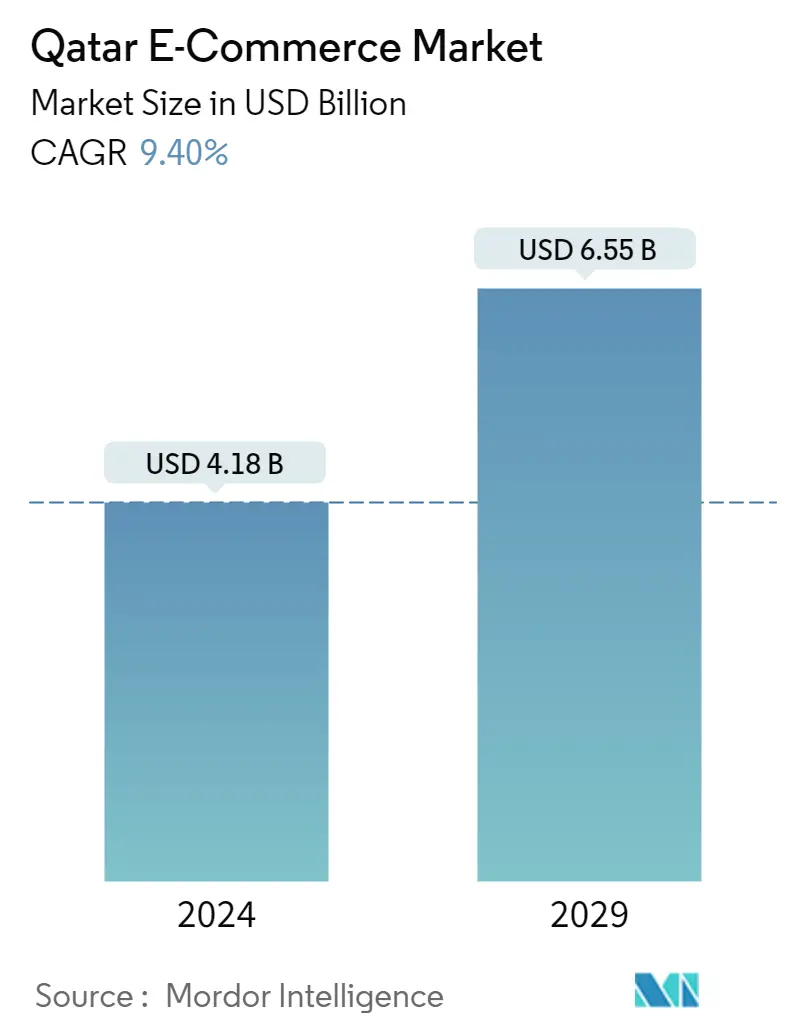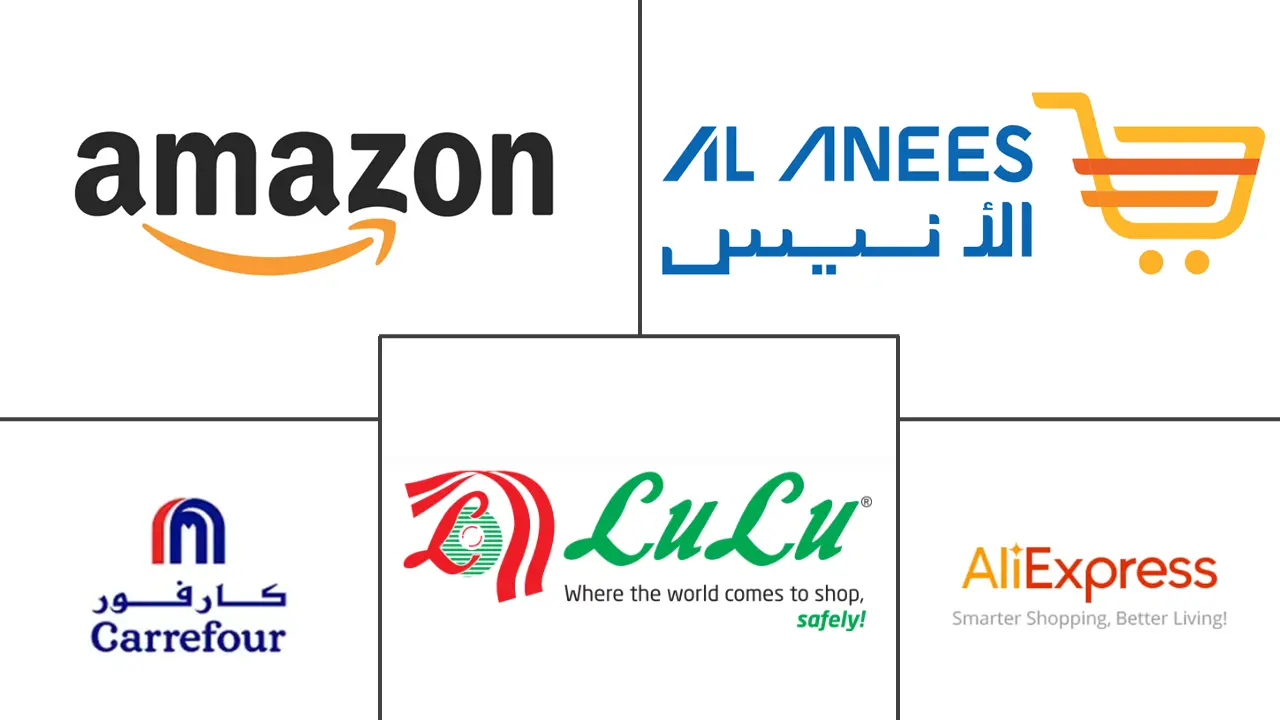Market Size of Qatar E-Commerce Industry

| Study Period | 2019 - 2029 |
| Base Year For Estimation | 2023 |
| Market Size (2024) | USD 4.18 Billion |
| Market Size (2029) | USD 6.55 Billion |
| CAGR (2024 - 2029) | 9.40 % |
| Market Concentration | Medium |
Major Players
*Disclaimer: Major Players sorted in no particular order |
Qatar Ecommerce Market Analysis
The Qatar E-Commerce Market size is estimated at USD 4.18 billion in 2024, and is expected to reach USD 6.55 billion by 2029, growing at a CAGR of 9.40% during the forecast period (2024-2029).
With the highest GDP per capita in the world and a reliance on international partners to fulfill strategic goals, Qatar emerges as an excellent place for commercial growth, creating economic prospects for many nations. In the near future, the e-commerce market in Qatar is expected to grow strongly, particularly in the services industry.
- The soccer tournament organized in Qatar in 2022 brought new opportunities for businesses to capitalize on this major event. As people from different countries turned out to watch FIFA World Cup, companies adopted various strategies to showcase their presence. FIFA introduced an online tool for event organizers who wanted to stage public viewing events during the FIFA World Cup Qatar 2022.
- FIFA World Cup official retail Partner, Qatar Duty-Free (QDF), launched the first FIFA store at Hamad International Airport. The store will have an impressive collection of FIFA Official World Cup merchandise, souvenirs, collectibles, and team jerseys. The move was to attract the tourists returning after the world cup. People can shop for memorable souvenirs to mark an unforgettable experience.
- The Formula One Grand Prix, Expo 2023, and the Asian Football Confederation (AFC) Asian Cup will occur in Qatar in 2023, providing travel and tourism companies with an excellent chance to create robust business developments.
- The outbreak of Covid-19 brought a fundamental and structural change in the retail industry. Many renowned brands have drastically reduced their presence on the high street or have switched to just conducting business online. The traditional retail sector has been forced to change and enter a new era. Online retail and physical retail will continue evolving together, but it is observed companies will invest in cutting-edge technologies and innovative stores.
Qatar Ecommerce Industry Segmentation
The internet trade of goods and services is known as e-commerce (or electronic commerce). These commercial dealings are either B2B (business-to-business), B2C (business-to-consumer), or C2C (consumer-to-consumer). A more recent business model is "direct-to-consumer" (D2C), allowing brands to sell directly to consumers. The internet is what drives e-commerce. Consumers use their devices to access an online store to browse the selection and order goods or services. Qatar emerges as an ideal location for business growth, as the country has the world's highest GDP per capita, attracting companies to invest and expand their business reach.
The Qatar E-commerce Market is Segmented by B2C ecommerce (Beauty and Personal Care, Consumer Electronics, Fashion and Apparel, Food and Beverage, Furniture and Home), and B2B ecommerce.
The market sizes and forecasts are provided in terms of value (USD million)
| By B2C ecommerce | ||||||||
| Market Size (GMV) for the study period | ||||||||
|
| By B2B ecommerce | |
| Market Size for the study period |
Qatar E-Commerce Market Size Summary
The e-commerce industry in Qatar is poised for significant growth, driven by the country's robust economic environment and strategic international partnerships. With a high GDP per capita, Qatar presents a fertile ground for commercial expansion, particularly in the services sector. The hosting of major events like the FIFA World Cup in 2022 has further catalyzed this growth, providing businesses with opportunities to enhance their presence and capitalize on the influx of international visitors. The retail sector experienced a surge in activity, with new stores and expansions occurring in anticipation of these events. This trend is expected to continue with upcoming events such as the Formula One Grand Prix and the AFC Asian Cup, which will further stimulate the e-commerce market.
The Qatari e-commerce landscape is becoming increasingly competitive, with significant investments in advanced technologies like AI and IoT to streamline operations and enhance profitability. Major players such as Baqaala, Amazon, and IKEA Qatar are at the forefront, leveraging automation to improve their business frameworks. The market is also witnessing innovations like the launch of fully automated stores and digital platforms by companies such as Nasser Bin Khaled Automobiles and Samsung Gulf Electronics. These developments are indicative of a broader shift towards digitalization in retail, as businesses adapt to changing consumer behaviors and preferences in the post-COVID era.
Qatar E-Commerce Market Size - Table of Contents
-
1. MARKET INSIGHTS
-
1.1 Market Overview
-
1.2 Industry Attractiveness-Porter's Five Forces Analysis
-
1.2.1 Bargaining Power of Suppliers
-
1.2.2 Bargaining Power of Buyers/Consumers
-
1.2.3 Threat of New Entrants
-
1.2.4 Threat of Substitute Products
-
1.2.5 Intensity of Competitive Rivalry
-
-
1.3 Key market trends and share of e-commerce of total Retail sector
-
1.4 Impact of COVID-19 on the e-commerce sales
-
-
2. MARKET SEGMENTATION
-
2.1 By B2C ecommerce
-
2.1.1 Market Size (GMV) for the study period
-
2.1.2 By Application
-
2.1.2.1 Beauty and Personal Care
-
2.1.2.2 Consumer Electronics
-
2.1.2.3 Fashion and Apparel
-
2.1.2.4 Food and Beverage
-
2.1.2.5 Furniture and Home
-
2.1.2.6 Others (Toys, DIY, Media, etc.)
-
-
-
2.2 By B2B ecommerce
-
2.2.1 Market Size for the study period
-
-
Qatar E-Commerce Market Size FAQs
How big is the Qatar E-Commerce Market?
The Qatar E-Commerce Market size is expected to reach USD 4.18 billion in 2024 and grow at a CAGR of 9.40% to reach USD 6.55 billion by 2029.
What is the current Qatar E-Commerce Market size?
In 2024, the Qatar E-Commerce Market size is expected to reach USD 4.18 billion.

